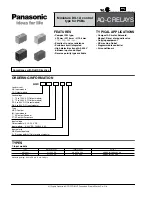
3-12
UR FAMILY – COMMUNICATIONS GUIDE
OVERVIEW
CHAPTER 3: IEC 61850 COMMUNICATION
3
the interval of periodic reports. OptFlds is a bitmapped value, wherein each bit specifies whether an optional particular
field is to be included in the message: sequence-numer, report-time-stamp, reason-for-inclusion, data-set-name, data-
reference, buffer-overflow, entryID, and/or conf-revision.
3.1.7 Commands
IEC 61850 controls are complex. The following is a brief description.
From a UR perspective, you can issue open or close controls to the UR Breaker Control element using IEC 61850
controllable points.
This is accomplished by standard IEC 61850 models and services. Bkr0XCBR1.Pos is a DPC (Dual Point Control) point that
drives the Breaker Control 1 element. BkrCSWI1.Pos is also a DPC point that drives the Breaker Control 1 element. Of
course, the Breaker Control element can be used entirely outside of IEC 61850 by using FlexLogic operands as the control
inputs.
Similarly Disc0XSWI1.Pos and/or DiscCSWI1.Pos can be used to control the Disconnect Switch 1 element.
From an IEC 61850 standard perspective, controllable points can be SPC (Single Point Control, as used to control UR Virtual
Inputs), DPC (Dual Point Control, as used to control UR Breaker Control and Disconnect Switch elements), or other less
common control types.
Bkr0XCBR1.Pos is a DPC. It supports all IEC 61850 control models. The Pos.ctlModel attribute selects the control model,
where
1 = Direct Control with Normal Security
2 = SBO Control with Normal Security
3 = Direct Control with Enhanced Security
4 = SBO Control with Enhanced Security
In order to execute the IEC 61850 control services, you need to know the value of ctlModel. For Direct Control with Normal
Security, an IEC 61850 Client can write to the Pos.Oper structure. The entire Pos.Oper structure must be written in one MMS
write transaction. Pos.Oper.ctlVal determines whether the control is "open" or "close".
For SBO Control with Normal Security, the Pos.SBO element is used. A read of this element is the "select" operation. The
Pos.Oper structure can then be written as described above.
For Direct Control with Enhanced Security, only the Pos.Oper element is used. The client must write the entire Pos.Oper
structure in one MMS write transaction.
For SBO Control with Enhanced Security, the Pos.SBOw element must be written first. This is the "select" operation. The
Pos.Oper element can then be written.
Note that the SBOw element is always present if SBO with Enhanced Security is supported for a particular point, regardless
of the current value of ctlModel. Similarly, the SBO element is always present if SBO with Normal Security is supported,
regardless of the current value of ctlModel.
3.1.8 Substation Configuration Language (SCL)
The Substation Configuration Language (SCL) is a file format defined by IEC 61850-6 to describe/specify in a way
understandable by configuration tools of different manufacturers the capabilities and configuration of IEDs and
communication systems, as well as the relations between the utility automation system and the substation/switch yard,
and describe the switch yard topology.
SCL is based on the Extensible Markup Language (XML) version 1.0, and specified in IEC 61850-6 using the XML Schema
language. Both the SCL language and the XML Schema language are complex; only SCL features needed to obtain a high
level understanding of SCL files are discussed here.
An SCL file, being an XML file, consists of a root element, which contains child elements, which in turn contain child
elements, and so on. In SCL files, the root element is named SCL. Its standard child elements are as follows:
•
Header, which can be used to identify the SCL file, its version, and history
•
Substation, each of which describes the topology of a substation and either the assignment of logical nodes in the
IEDs to power system elements or the required types of logical nodes for each of its power system elements
















































